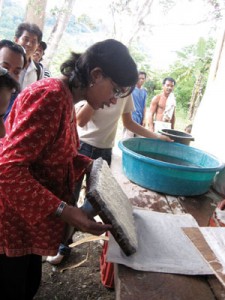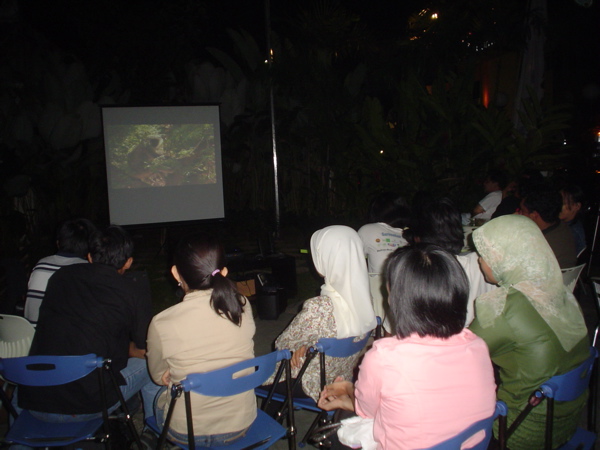Advocacy continues
Despite the postponement of the ASEAN Summit, the 2nd ASEAN Civil Society Conference (ACSC 2) pushed through from 10-12 December 2006 in Banilad, Cebu City. The postponement of ACSC 2 was viewed as an opportunity for participants to refine the statement to be presented to ASEAN in January 2007. Some gains from the meeting included:
> Expanding the profile of environmental organisations engaging the ASEAN and the ASEAN senior officials on environment (ASOEN)
> Highlighting of the issue of the trans-boundary haze and forest conversion for plantations and its inclusion in the statement to ASEAN
> Forging of stronger links with groups engaging in ASEAN like Solidarity for Asian Peoples Advocacies (SAPA) and Southeast Asian Sommittee on Advocacy (SEACA)
> Forging of stronger links with environmental groups already engaging at the international level and willing to raise nature and poverty issues at that level (Sustainability Watch-Asia).
In January, ASEAN agreed to establish a permanent forum for civil society members.
Sarawak project kicks off
There had been a strong response of Penan communities (Apoh Tutoh, Middle Baram, Sarawak, Malaysia) to NTFP-EP’s initial efforts at increasing awareness and field efforts on developing alternative livelihoods to adddress the threats of expanding oil palm plantations and destructive logging. A recent project possible through the support of NC-IUCN takes a more holistic stance. The project, headed by community development coordinator Dominic Langat, is aimed at securing food supplies, establishing native customary rights and providing alternative NTFP livelihoods of the Penans. Started January this year, the strategy is also aimed at strengthening Penan community leaders so that they may develop their own platform to collectively address their issues.
Coming together for the NTFPs of Latin America
NTFP-EP and Latin American organisations met at two workshops to discuss the Latin American adaptation of the manual Steps to Sustainable and Community-based NTFP Management: A manual developed with special reference to South and Southeast Asia, authored by Virtual academy member Dr. Mary Stockdale. The first workshop hosted by the Universidad Veracruzana was held in in Xalapa, mexico (28 February-3 March) and the second in Rio Branco, Acre, Brazil (7-9 March).
The enthusiasm of the group was apparent throughout the discussions. the manual, when adapted to the realities of Latin America and highlighting relevant case studies, is seen as a valuable resource in understanding and better managing of NTFPs in the region. the meetings have resulted in the formation of a Latin American NTFP network, and even greater enthusiasm for further collaboration in the near future. Read more here.
More sweet exchanges
Last december 2006, Bebek of Dian Niaga, marketing arm of the Indonesia Forest Honey Network visited Keystone Foundation in India to learn especially from the Green Shop experience. You can read insights of this trip here.
Meanwhile, Dr. Phung Luu Chinh of the Bee Research and Development Center, Hanoi, Vietnam brought his Apis dorsata honey expertise to the tribal communities of Sen Monorom, Mondulkiri province, Northeastern Cambodia last April. The training raised awareness on sustainable honey production and marketing from Mundolkiri experience on honey. The training was organised by WWF cambodia in collaboration with the NTFP-EP.
Looking 10 years ahead for CBFM
After ten years of implementing Community-Based Forest Management as the Philippine strategy for forest management, the Department of Environment and Natural Resources actively involved the wide array of stakeholders – including other government agencies, non-government organisations, peoples’ organisations, local government units and other partners in community forestry – in a series of workshop-consultations from January to March held across the country. Stakeholders are hopeful that the workshops translate into strategies with greater impact the local level {see article by Abi Aguilar}.
Going natural!
Last March, Higaonon weavers went to Lake Sebu, South Cotabato, the Philippines to join T’boli indigenous weavers to learn more about the use of natural dyes. This is a follow-up to their initial training held by the NTFP Task Force in February 2006.
The use of natural dyes is fast regaining popularity among women weavers of the higaonon indigenous community in Barangay Hagpa, Impasugong. Having shunned natural dyes for the more convenient synthetic commercial dyes, they are now beginning see the benefits of using natural dyes to color their abaca fibers (also known as Manila hemp), which they weave into their colorful hinabol or traditional Higaonon woven cloth. The naturally dyed woven cloths fetch higher prices than those dyed synthetically. Morever, the move has also promoted biological diversity. Ilalama, a tree dye source, is found to be getting scant in barangay hagpa. the women from tugunganon village are now planting this species so they can have continuous source of orange to brown dye color.
Making markets work for NTFPs
The work of NTFP-EP’s partners was recently showcased last 16-20 April in back-to-back meetings at The Hague, the Netherlands. The event was hosted by Cordaid. Of particular interest was how the years of training, exploration and capacity building has borne fruit. Major issues discussed were:
> To what extent can small-scale extraction and processing of forest products help access stable markets and enhance local livelihoods?
> What is the potential of the emerging markets for forest based products in asia, europe and the Netherlands, apart from the Fair trade stores?
> How can the private sector in europe be further interested in such products?

A highlight was the public meeting – with close to 100 representatives of donor agencies, the private sector, and NGOs in attendance. interest was generated of the organisations’ experiences of working in the field of NTFPs, and on the specific NTFPs. this was complemented by a mini-display/store of products, and judging by the enthusiastic response, will gain orders in the future. NTFP-EP also took the opportunity to discuss future collaboration with Cordaid and other donors, including HIVOS, DOEN, and IUCN-NL.
Synergy and exchange
Last 2-5 May, the NTFP-EP came together with contacts from the Nature and Poverty Southeast Asia and the Pacific Alliance for a regional planning, synergy and exchange in Palawan, the Philippines. Discussions focused on how to maximize collaborative efforts on enhancing the knowledge and learning network on nature and poverty linkages (natureandpoverty.net). Also discussed were common issues such as oil palm expansion, watershed management, and logging campaign; as well as the evaluation of the first phase of N&P. SawitWatch was identified as the host organisation for liaison. N&P, implemented by the IUCN-NL, is a collaborative program in three continents addressing conservation and poverty alleviation in marine and forest ecosystems. the meeting was sponsored by IUCN-NL and hosted by the NTFP-EP.
21 years of BothENDS
During its 21st anniversary, European partner BothENDS invited its partner NGOs to a week-long celebration last March. It also coincided with the launch of the Joke Waller-Hunter Initiative, which enables talented people who work at environmental organisations in the south to develop themselves further. Partners from NGOs and networks in Africa, Latin America and Asia joined in the celebration. {see Vince Docta’s article.}
New book on NTFPs
Last April 20, Madhu Ramnath’s Plants of Bastar: a Fieldguide was launched in the Botanical Gardens of Amsterdam. It was a festive and very well-attended occasion at a location where the author earlier on found inspiration and encouragementmadhu who is currently working as EP India Field Coordinator, has been working on this field guide over the last 15 years.the book was published with financial support from NC-IUCN and the Van Tienhoven Foundation. {Further details and ordering info are available here}








